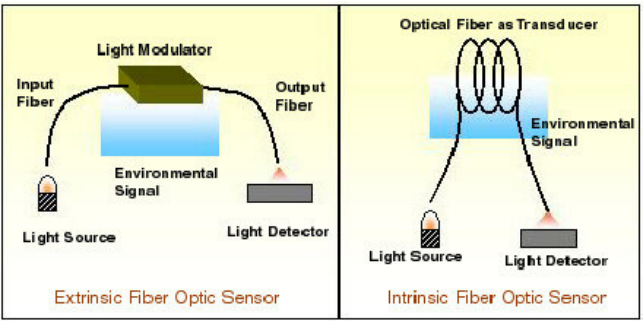
Fiber optic sensors are increasingly gaining attention in the electronic components industry. Their unique working principles and wide range of applications position them as critical components in modern technological applications. This article delves into the definition, working principles, types, characteristics, advantages, and applications of fiber optic sensors.
Catalog
I. What Are Fiber Optic Sensors?
III. Types of Fiber Optic Sensors
IV. Characteristics and Advantages
I. What Are Fiber Optic Sensors?
A fiber optic sensor is a device that uses optical fiber either as the sensing element ("intrinsic sensors") or as a means of relaying signals from a remote sensor to the electronics that process the signals ("extrinsic sensors"). These sensors detect and transmit information through changes in the optical signals within the fiber, widely used for measuring parameters such as temperature, pressure, strain, and vibration.
II. Working Principles
The working principle of fiber optic sensors is based on the propagation characteristics of light in optical fibers. An optical fiber, made of glass or plastic, can transmit light waves through total internal reflection. Changes in the external environment (such as temperature, pressure, strain, etc.) affect the propagation characteristics of light within the fiber (such as phase, wavelength, intensity, etc.). By detecting these changes, the sensor can monitor the measured parameters.
· Phase Changes: External strain or pressure causes changes in the phase of the light signal, which can be detected using interference techniques.
· Wavelength Changes: Variations in temperature or strain lead to shifts in the wavelength of the light reflected by fiber Bragg gratings (FBGs). Measuring these shifts allows for accurate measurement of the physical quantities.
· Intensity Changes: The intensity of the light signal may change due to environmental variations. Monitoring the changes in light intensity enables the detection of external conditions.
III. Types of Fiber Optic Sensors
Fiber optic sensors are mainly categorized into intrinsic and extrinsic types:
· Intrinsic Fiber Optic Sensors:
In these sensors, the measurement occurs within the optical fiber itself, making the fiber an integral part of the sensing element. They can measure strain, temperature, pressure, and other quantities by modifying the fiber so that the quantity to be measured modulates the intensity, phase, polarization, wavelength, or transit time of light in the fiber. They are capable of distributed sensing over large distances and can detect changes directly within the fiber. Common examples include fiber Bragg grating (FBG) sensors.
· Extrinsic Fiber Optic Sensors:
In these sensors, the measurement takes place outside the optical fiber. The fiber merely acts as a medium to transmit modulated light from either a non-fiber optical sensor or an electronic sensor connected to an optical transmitter. They can access places that are otherwise unreachable. The modulated light, after being affected by external conditions, is conducted back into the fiber. Common examples include extrinsic interferometric sensors.

IV. Characteristics and Advantages
· Electromagnetic Interference Immunity: Fiber optic sensors use light signals, making them immune to electromagnetic interference, which is ideal for complex electromagnetic environments.
· High Sensitivity: They can detect very small changes in physical quantities, suitable for high-precision measurements.
· Compact Size and Lightweight: Their compact structure makes them easy to install and integrate, suitable for applications where space or weight is limited.
· Corrosion Resistance: Optical fibers are highly resistant to corrosion, making them suitable for long-term monitoring in harsh environments.
· Long-Distance Transmission: Light signals can be transmitted over long distances with low loss, making them suitable for large-scale monitoring.
V. Applications
· Industrial Automation: Used for machine condition monitoring, structural health monitoring, and process control.
· Power Industry: Used for temperature monitoring of high-voltage equipment and fault detection in cable lines.
· Transportation: Applied in the health monitoring of railways and bridges, and in vehicle safety systems.
· Medical Field: Used for patient monitoring and real-time monitoring during surgical procedures.
· Oil and Gas: Employed for pipeline leak detection and downhole monitoring.
· Environmental Monitoring: Used for water quality monitoring and atmospheric monitoring.
VI. Conclusion
With their unique advantages, fiber optic sensors are playing an increasingly important role in the electronic components industry. As technology continues to innovate and market demand grows, the application prospects for fiber optic sensors are broad. Whether in industrial automation, power, transportation, medical, oil and gas, or environmental monitoring, fiber optic sensors demonstrate immense potential and value.




